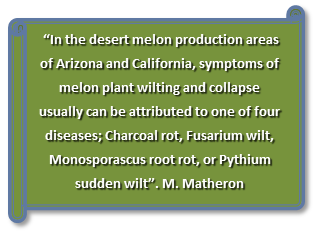Temperatures are rising, melon plantings are maturing, and sudden wilt and death
of melon plants is occurring. What causes this sudden collapse of plants? In the
desert melon production areas of Arizona and California, symptoms of melon plant
wilting and collapse usually can be attributed to one of four diseases; Charcoal
rot, Fusarium wilt, Monosporascus root rot, or Pythium sudden wilt. Each of these
diseases is caused by a different soil-borne plant pathogen, so knowing what management
options might be available first requires accurate identification of the responsible
pathogen. Charcoal rot and Fusarium wilt, caused respectively by the fungal pathogens
Macrophomina phaseolina and
Fusarium oxysporum, are not effectively
controlled by fungicides. Preventative actions that may lessen the severity of these
diseases include planting resistant melon varieties when available (for Fusarium
wilt) and minimizing plant stress. Plant stress due to over- or under-irrigation
can be managed; however, other crop stress factors such as fruit load and hot temperatures
are obviously beyond your control. Monosporascus vine decline, caused by
Monosporascus
cannonballus, can be suppressed by application of the fungicide Cannonball
at seeding or transplanting followed by additional applications as specified on
the product label. The other disease mentioned was Pythium sudden wilt.
Pythium,
the pathogen that causes this disease, is a fungus-like soil-borne organism that
can be managed by fungicides, such as mefenoxam. However, the difficulty in preventing
extensive Pythium sudden wilt is that once this disease is initially identified
in a field, rapid deployment of an effective fungicide treatment will protect noninfected
plants but may not save plants already infected but not yet displaying sudden wilt
symptoms. Knowing the disease history in a particular field for melons can help
in preparing for possible recurrence of that disease in a future planting.



